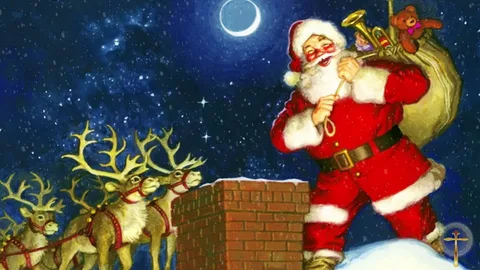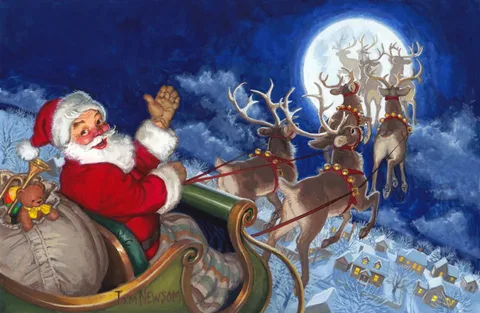Published on The Walls New Christmas is a time for joy, celebration, and a spirit of giving—and at the heart of these traditions stands a beloved figure: Santa Claus. This jolly, red-suited man who travels the world delivering gifts to children has become an integral part of Christmas culture. But how did Santa Claus evolve into the figure we know today, and what does he truly represent in the context of Christmas history and culture? Let’s dive into the fascinating origins and significance of Santa Claus.
The Origins: Saint Nicholas, the Generous Bishop
The modern image of Santa Claus can trace its roots back to Saint Nicholas, a 4th-century Greek bishop from Myra (in present-day Turkey). Known for his generosity and kindness, Saint Nicholas became famous for secretly giving gifts to children and helping the poor. His love for helping those in need earned him a reputation as a protector of children, and he eventually became the patron saint of children in Christian tradition. The story of Saint Nicholas and his selfless acts of charity set the foundation for the Santa Claus we know today.

The Dutch Influence: Sinterklaas
As Dutch settlers migrated to America in the 17th century, they brought with them the tradition of Sinterklaas, a figure closely tied to Saint Nicholas. In Dutch folklore, Sinterklaas was a saintly man who arrived from Spain each year on December 5th, bringing gifts to well-behaved children. The Dutch pronunciation of “Sinterklaas” eventually evolved into “Santa Claus” in English.
The Dutch settlers in New York, then known as New Amsterdam, introduced Sinterklaas to early American culture. Over time, elements of Sinterklaas merged with other Christmas traditions, laying the groundwork for the Santa Claus we now recognize.
Clement Clarke Moore and the Birth of Modern SantaIn 1823, the poem “A Visit from St. Nicholas,” better known as “The Night Before Christmas,” was published by Clement Clarke Moore. This poem helped shape our current image of Santa Claus by describing him as a jolly, rotund man who flies around the world on a sleigh drawn by reindeer, delivering gifts to children on Christmas Eve. Moore’s portrayal of Santa emphasized his cheerful and magical nature, further solidifying his role in the Christmas story.
In the poem, Santa is described with iconic details—his “jolly old elf” appearance, his red suit, his snowy beard, and the famous “Ho, Ho, Ho!”—which all became integral to Santa’s image in modern culture.
The Coca-Cola Influence: Santa’s Signature Look
While the poem by Moore set the stage for Santa’s physical description, it wasn’t until the 1930s that Coca-Cola played a major role in popularizing the image of Santa Claus worldwide. Through a series of advertisements, Coca-Cola depicted Santa as a warm, friendly figure wearing a red suit with white fur trim, enjoying a Coke in the winter snow. This portrayal helped cement Santa’s image as a joyful, plump, and approachable figure—an image that is now universally recognized.
The advertisements, coupled with Coca-Cola’s global reach, made Santa Claus a central character in the holiday season, influencing how generations of people around the world view Christmas.
Santa Claus: A Symbol of Generosity and Joy
Today, Santa Claus is much more than just a figure from holiday folklore. He has become an enduring symbol of generosity, goodwill, and the magic of Christmas. Santa represents the spirit of giving, as he is known for bringing joy to children and adults alike by delivering presents and spreading cheer. His story reminds us of the importance of kindness, compassion, and selflessness.
Beyond the gifts, Santa’s presence during the holiday season brings a sense of wonder and excitement, especially for children. The idea that Santa is watching over the world, keeping track of who has been naughty or nice, helps reinforce the values of good behavior and kindness.
Santa in Different Cultures
While Santa Claus is universally associated with Christmas, different countries have their own variations of this beloved figure. In the UK and parts of Europe, Father Christmas shares many similarities with Santa, but he is often portrayed as a more formal figure, sometimes with a more traditional, Victorian-style outfit. In France, Père Noël brings gifts on Christmas Eve, while in Spain and Latin America, Papá Noel is the Spanish version of Santa Claus.
Despite these regional differences, the underlying theme remains the same: Santa is a figure of joy and generosity, bringing people together and celebrating the spirit of the season.
Santa Claus Today: A Cultural Icon
In the modern era, Santa Claus has become one of the most recognized figures in the world. He has transcended his origins as a religious figure and folklore character, becoming an essential part of the secular celebration of Christmas. From department store appearances to holiday movies, songs, and advertisements, Santa’s influence is felt everywhere. He is a commercial icon, a symbol of the magic and happiness that Christmas brings to families, children, and communities around the world.
Conclusion: The Enduring Legacy of Santa Claus
Santa Claus, with his roots in Saint Nicholas, Sinterklaas, and American folklore, has evolved into a global symbol of Christmas. His image represents much more than just gift-giving—he embodies the joy, magic, and warmth that make the holiday season so special. Santa Claus reminds us that Christmas is not just about the presents, but about sharing kindness, spreading love, and creating moments of happiness and wonder.
At The Walls New, we celebrate this timeless figure, whose legacy continues to inspire wonder and joy every holiday season. Whether you leave cookies for him or share stories of his adventures, Santa Claus remains an enduring part of Christmas history and culture, bringing us together in the spirit of generosity and celebration.




